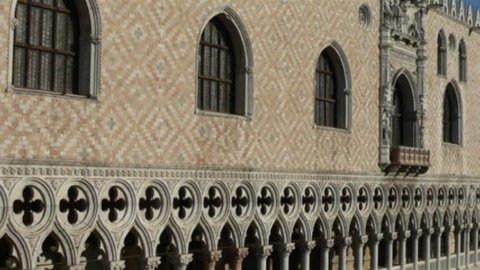From the March 8 to September 22, 2013, Doge's Palace in Venice hosts in the headquarters of the "power" of the Serenissima the evocative and suggestive Sala dello Scrutinio, the exhibition "PALAZZO DUCALE, Venetian Fortresses of the Mediterranean" which represents the first of the three scheduled exhibitions dedicated in 2013 to the rediscovered treasures, i.e. to those works from from the vast and articulated artistic and bibliographic collections of the Fondazione Musei Civici di Venezia which are not normally exhibited to the public.
Exhibition card: the exhibition, curated by Camillo Tonini and Diana Cristante, reconstructs, through a selection by exempla, chosen from the numerous and interesting materials of the Cabinet of Cartography and the Library of the Correr Museum, the Venetian military defense systems and the "cornerstones" forts of the Stato da Mar. It will thus be possible to admire the representations of forts and fortresses, built in the strategic and most sensitive places along the Venetian maritime routes of the Mediterranean, in order to secure vital trade with the Levant. Graphic works, between the XNUMXth and XNUMXth centuries, created with extraordinary skill by technicians at the service of the Republic, illustrate the key role of Corfu and Cyprus or the weight, even symbolic, of the "bulwark" of Candia (Crete).
It is also worth noting the attention dedicated to the defensive network of the Dalmatian coasts and of Venetian Albania, as well as the projects for the Morea which was continually exposed, after the reconquest by Francesco Morosini at the end of the seventeenth century, to the reassembling Turkish expansion.
Among the main works that the exhibition presents, in the section dedicated to the 1537th century, there is an interesting and rare parchment with the representation of the fortifications of Corfu. The island, essential for controlling access to the Adriatic, received particular attention especially after the siege of XNUMX. This map, which can be dated to the end of the century, summarizes, highlighting them with a red sign, all the curtains of the defensive system built during the Five hundred.
It will also be possible to see a plan of Zara datable between 1564 and 1567 with an ambitious project, never realised, to expand the defensive walls beyond the port to protect its structures, but also to welcome the inhabitants of the countryside and avoid the risk of being taken prisoner in the event of an attack. In the next section you can admire the refined images of the fortresses of the island of Candia (Crete) created by Angelo degli Oddi (1603) and Francesco Basilicata (1618). Also dedicated to Crete is the display case which presents the punctual and precise drawings which establish one of the phases (1668) of the siege of the fortress of Candia (Iraklion).
For the eighteenth century it is worth mentioning the projects of Matthias Johann von der Schulemburg for Corfu which will be defined as "the most beautiful and strongest square of all in Europe", represented here by a plan dated 1727, perhaps attributable to the hand of the engineer Antonio Moser de Filseck.
Also to be mentioned, again for this section, is the presence of some of the tables forming part of a series of design drawings carried out on behalf of Francesco Grimani, at the time Provveditore generale da Mar, in 1706 for the Morea fortresses. Venice perhaps links this ambitious defensive work with the last longed-for hope of re-emerging as "lady of the seas".





